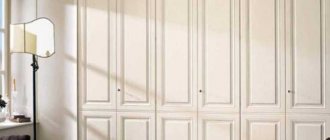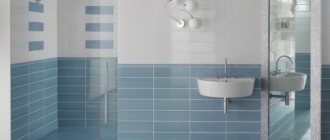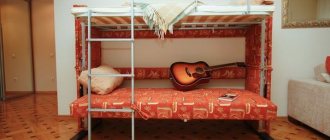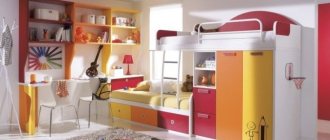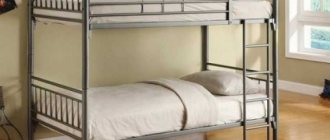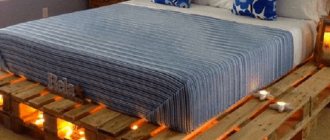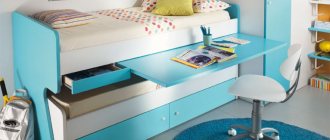Not everyone can afford to purchase a spacious apartment with several rooms, where you can easily place the furniture you like. For owners of small-sized homes, a bunk bed will be a real salvation - a practical and useful design that can combine 2 sleeping places or a small sofa. Many manufacturers produce models that combine a bed and a study desk. Before you go on a search, you need to figure out what types of similar structures exist, study their features, and become familiar with the selection criteria.
Features depending on purpose
There is a common misconception that a bunk bed is a piece of furniture intended exclusively for arranging children's rooms. But today, such structures are increasingly being placed in dachas, country houses, and hostels. The main feature of the attribute is that the sleeping places are located on top of each other, which allows you to significantly save space and install the product even in small rooms. Other advantages of wooden or wrought iron bunk beds include:
- Functionality. In most cases, the lower tier is equipped with drawers or compartments where you can store bedding and other things.
- Practicality. Often, instead of a lower tier, the model is supplemented with a desk, chest of drawers or a small sofa, thanks to which the design serves as two products at once.
- Originality. The bunk bed differs in size and design. If standard models are more often purchased for adults, then beds intended for children can look like a car, a bus or a castle - it all depends on the imagination of the manufacturer.
- Affordable price. Purchasing such a model will be cheaper than purchasing two separate beds.
As for the disadvantages, the main disadvantage of such products is the risk of injury. But this only applies if the attribute is purchased for a child. Having played too much, the baby may simply fall from the second tier. Another drawback is the massiveness of the structure.
For adults
In most cases, a two-level bed intended for adults and children differs only in dimensions and external design. But some designs also differ in functionality. Features of products for adults include:
- Large sizes - the length of the product varies from 190 to 200 cm. For many models, this parameter is adjusted by extending the structure.
- Since furniture has to withstand heavy loads (up to 130 kg), the structures are durable. They are made using thick boards and high-quality fittings.
- There are models where the lower zone is double.
- Such products have a simple, laconic design.
For home use, such designs are purchased only if the apartment does not have space to accommodate several beds. They are usually installed in guest or country houses. Bunk beds for hostels are also very popular because they can accommodate more visitors in one room.
For children
A bunk children's bed is also made from different materials and differs in size. Products intended for teenagers and high school students, as a rule, have a width of 80 and a length of 190 cm. The length of designs for small children varies from 120 to 180 cm, and the width is about 70 cm.
A characteristic feature of products for children is their fabulous design. Designs can be made in the form of a car, a spaceship, a palace, or even an animal. Models with a non-standard design can be found in furniture departments or ordered individually. Another difference between structures intended for children is the high sides on the second floor. Beds equipped with this addition are less dangerous. Even if the child starts playing, he will not fall, since the high sides will protect him from falling. It is worth considering that some manufacturers produce non-standard designs designed to accommodate not 2, but 3 or 4 children.
The optimal distance between the floors of the bed is 90 cm.
What to look for when buying a bed?
Having decided to purchase and considering the sizes of a bunk children's bed, the options of which allow you to choose the one you like, you should pay attention to the following details:
- Sustainability. To check this parameter, you should carefully examine the legs of the bed. Looseness and defects are not allowed.
- The optimal distance between two sleeping places. It should be sufficient for comfortable sitting on each of them. At the same time, the child should not be afraid of heights when climbing to the second floor.
- Side size. To prevent falls and other unpleasant situations, the height of the sides should be 35 centimeters.
- Decoration of steps. The steps should be placed at an angle of 45-50 degrees and equipped with handrails.
- Selecting a bed based on its base. The ideal option is wood. In this case, ash, beech or oak should be used: they lend themselves well to processing and sanding.
Along with it, metal or plastic can be used. However, only the headboard and footboard should be created from the latter. Legs can be made from steel.
Types of designs
Manufacturers offer a wide range of standard bunk beds, models with a work area or with a sofa below. They differ in material of manufacture, configuration, shape, dimensions. To choose the right model for your apartment, you need to understand the features of each type.
Standard
A classic two-level bed with an attached or an extension ladder is the most common and popular model. Designs of this type are easy to manufacture and consist of 2 berths, one of which is located below and the other on the second tier. Such a product is durable, and since it does not have to be folded and reassembled every day, if treated with care, the attribute will last for many years. Classic bunk beds with drawers where the child can put toys or other accessories are very convenient - such models can significantly save space.
Modern bunk beds made of solid wood in the interior of a nursery
Most often, products of this type are installed in a room where two children live with a small age difference. Typically, the older child sleeps on top and the youngest on the bottom. Such a two-level attribute can only be installed in a room where the ceiling height is at least 2.35 m, otherwise sleeping on the second tier will be uncomfortable.
Transformer
Convertible beds are usually made of metal. Due to their versatility and practicality, such models are popular all over the world. It is worth considering that they differ in the method of transformation. The following options are considered the most popular:
- Bed with sofa underneath. Most often, structures of this type are purchased for one-room apartments, where there is no space to place excess furniture. During the day, the lower part of the attribute transforms into a small sofa, and at night into a full-fledged bed.
- Bed with a lifting mechanism in the form of a wardrobe. If necessary, the sleeping place is raised to the wall, after which the attribute looks like an ordinary wardrobe with mirrors and shelves. Such products are very ergonomic and beautiful, suitable for storing various things. Their only drawback is their high cost.
- Folding model. The basis of the product is not a frame, but a body, on two levels of which sleeping places are installed. During the day, folding bunk beds are folded and transformed into a closet with shelves, and at night they are used for sleeping.
- Pull-out bed. Such options are usually installed in children's rooms. Since under the bed there are drawers for storing linen, clothes, toys, this design allows you to significantly save space.
If you decide to purchase a transformable bunk bed, it must be selected in accordance with the individual characteristics of the person. You first need to think about which product will be more appropriate and necessary in a particular case. It is worth considering that most models are intended not only for recreation, but have wider functionality.
With a sofa below
Wardrobe bed
Folding
Retractable
Matryoshka
A matryoshka bed is a product that consists of a frame with several pull-out compartments. This attribute is indispensable not only for small apartments, but also for kindergartens, since it allows you to save square meters. If you unfold such a bed, it will take up 2 sleeping places, but if you assemble it, it will take up only one. This frees up space for games and homework.
In most cases, double-decker Matryoshka beds are equipped with low sides that prevent the mattress from moving to the side and also prevent the child from falling during sleep. Another feature of the model is its low height. The child will be able to climb onto the second tier without the use of a chair, ladder or other devices. The side elements often have rounded corners, which reduces the risk of injury to the product. As a rule, models of this type are made of chipboard or MDF. Almost no metal is used for their production.
Attic
Usually it is a bed with a workplace. The relaxation area is often located on the upper tier, and the first is intended for daytime activities. Depending on the age of the child, the lower part can be made in the form of:
- Tables for studying and doing homework.
- Play areas.
- A chest of drawers with drawers and open shelves for storing clothes, textbooks, and sports equipment.
Also popular are bunk beds with a Swedish wall, where the child can play sports. In modern models with a sports complex in the side part, the lower tier is often transformed into an additional sleeping place. It is worth considering that the attic is suitable not only for a child, but also for an adult. If necessary, you can even find triple bunk beds of this type, when there are two sleeping places on the second floor. This product is fixed to the floor using wooden or metal supports.
A separate group includes bunk beds for workers, which are installed in cabins. Such designs are simple and do not have additional elements.
Tier options
Furniture factories offer many models that differ not only in design, materials, colors, but also in design options. The popular bunk bed for children, in which there are sleeping places on the lower and upper tier, is already considered a classic. Modern models offer several new and original interpretations of two-story furniture.
First
It is the lower tier that can boast of multifunctionality. In a children's room there are always several zones, and the rooms, most often, are not very spacious. Therefore, the first floor is used for different purposes:
- the workplace is built into the student’s furniture. Since the width of the bed is never less than 0.7-0.9 m, a comfortable place for studying is created below. A deep and long tabletop, open shelves and closed drawers make the learning process comfortable;
- The play area is important for kids. This two-level bed is suitable for one child. In a small area under the bed, you can lay out pillows or bolsters so that the child can sit down comfortably, or put a neat box for storing toys. A thick curtain that can be easily drawn will be an excellent game element;
- the sleeping place is most often arranged for the second child. The dimensions of the bed of the first and second tiers are the same or the lower bed is 20-30% wider;
- a relaxation corner is chosen for a teenager’s room. At this age, communication with friends is of great importance. Frequent guests will sit comfortably on the sofa. It is important that the upper tier does not prevent children from moving freely under it.
The storage system is an excellent option for a compact nursery. As a rule, it includes a cabinet with hinged doors and several drawers. In order to rationally use the space, boxes are even installed in the steps.
Second
This tier is traditionally allocated for sleeping space. For small children, the beds are made low so that the child can easily climb to the second floor. Models for teenagers should be tall enough to make it comfortable to sit in bed. On a small table installed near the head, you can put books, gadgets, and necessary little things.
In some designs, lockers for storing things are also installed on the second tier. As a rule, in such products the sleeping places are located on the same line, but are not strictly below each other.
Variants of shapes and locations of berths
The shape of the sleeping areas of military bunk beds or products intended for home use does not change and is always a rectangle. There are no square models or furniture with a round sleeping area, since structures of this type will take up too much space, which is irrational. As for the location of the beds, in most cases they are parallel to each other. At the same time, the size of the lower tier completely corresponds to the upper one. If the bed comes with an additional sleeping place - a third, then more often it is located under the first floor and is a drawer. The dimensions of this zone are slightly smaller compared to other tiers. Many manufacturers have begun to make such a compartment mobile. You can simply pull it out and place it anywhere, and push it back in the morning.
Pros and cons of pull out bunk beds, popular designs
As for the size of the bed, as a rule, it corresponds to the following parameters:
- 90 x 190 or 80 x 190 cm - a single bed for a teenager or an adult;
- 70 x 150 cm - bed for babies;
- 140 x 190 - lower double bed for parents.
It is worth considering that such beds can be free-standing or built-in - models of the latter type cannot be moved. Furniture is also divided into classic and corner. Both types are universal and suitable for all interiors.
Parallel arrangement of beds
Perpendicular arrangement of berths
With extra bed
Where can I see the bed making process?
Along with reading the instructions, you can watch videos. However, you should be careful when selecting videos.
Many of them indicate only individual fragments, for example, the dimensions of a bunk children's bed, manufacturing, or individual fragments of construction. Such videos are most often shot by amateurs. On the one hand, this is good: the masters can offer some original idea. On the other hand, it is uninformative: all well-known facts are hidden or little discussed.
That is why the best solution is to read the instructions in the article. Here you will find all the nuances and additional details for fully making a bunk bed with your own hands, where there is one sleeping place on top and additional space for work or play below.
Making a children's bed is a troublesome task and requires patience. However, if the child’s wishes are taken into account, such work can only bring the most positive impressions and give an unforgettable childhood to your beloved child, who will have his own unique nursery.
Stair configurations
Another parameter by which bunk beds differ is the staircase. Most often it is made from the same material as the frame. When choosing a product, you need to take into account not only functionality, but also the age of the people for whom the bed is selected:
- Vertical with podium. This product is fixed to the bed and is distinguished by the presence of a raised part in the lower zone. The design is quite stable and suitable even for preschoolers.
- With boxes in the steps. Due to the presence of boxes, the structure is equipped with wide steps, so it will be safe to move along it. Since you can store different things inside the drawers, they can save space.
- Inclined. As a rule, such structures are placed on the second floor - they are not considered the safest.
- Attached. When you need to climb to the second floor, such a ladder is moved towards the bed, after which it can be removed. If the lower part of the structure is wide and stable, the product is considered completely safe.
If the design is purchased for children, preference should be given to inclined or staircases with drawers. Such models are considered the most convenient and safe. Another good option for a child is chest of drawers for bunk beds, which can be used not only for their intended purpose, but also for storing things.
Vertical
With drawers in the steps
Inclined
Pristavnaya
Sequence of actions when making a bed
You should take into account not only the size of the bunk children's bed, but also the accuracy of the work. It is better to check it many times and do it once rather than rush in this matter. The work proceeds as follows:
- On the racks, you should calculate in advance the placement of wooden boxes intended for laying mattresses.
- Holes are made in wooden structures using a drill.
- In future legs, holes are made for screws on both sides.
- Fasten the backs to the legs using self-tapping screws.
- Secure the bottom on top on which the mattress will be placed.
- The cross beams of the lower and upper floors are fastened together.
- The frame of the resulting box is covered with boards on the sides. It is best to use screws with countersunk heads.
- The sides are fixed on the sides of each structure.
- A ladder is made and installed on the side of the lower bed.
At the end of the work, the child should be given the opportunity to check the strength, reliability and safety of the structure. However, this must initially be done by the adult himself.
Manufacturing materials
To produce beds with two or three sleeping places, different materials are used, both natural and synthetic. When choosing a product, you need to pay special attention to this point, as the strength and reliability of the structure depends on it. The following materials are most often used:
- Wood boards (chipboard, MDF, laminated chipboard). They are produced by pressing shavings and sawdust with adhesive compositions. MDF is considered the most reliable and environmentally friendly - these boards contain no toxic substances, and with careful use they will last for many years. Chipboard and laminated chipboard are one step lower, their quality is worse. Such materials are resistant to moisture and high temperatures.
- Natural array. Premium environmentally friendly material. Wood is rarely used to make bunk beds. To maintain an attractive appearance, it requires appropriate care.
- Metal. Beds made from this material are the strongest and most durable. Such products are able to withstand increased loads and can be made in the most complex configurations. Their disadvantage is that they do not fit into all interiors.
As for the boxes, they are usually made of base material. In budget models they are often made of plywood. Such sheets are quite fragile and require careful handling.
It is not necessary to purchase such a product for a dacha or village. If you wish and have minimal experience in construction, you can easily make a bunk bed from pallets.
The base of the bed can be with a hard solid bottom made of slats. The first option is made of chipboard, plywood, and is cheaper. Its disadvantage is that it does not provide good ventilation, which is why the mattresses do not provide orthopedic characteristics and last less. Beds with slatted bottoms are lighter, more mobile, suitable for children, and can withstand loads of up to 150 kg. They are more expensive because they provide an orthopedic effect.
Pros and cons of bunk beds for teenagers, popular models
MDF
laminated chipboard
Natural massif
Metal
Selecting a mattress for bunk beds
When calculating the dimensions, a do-it-yourself bunk children's bed should be equipped with additional elements for comfort. To ensure that your child not only sleeps comfortably, but is also healthy, much attention should be paid to the mattress.
It comes in two types: orthopedic and anatomical. The first helps support the spine in the correct position, and the second repeats all the contours of the human body. However, children under 14 years of age sleep better with orthopedic ones. The hardness of the mattress should be selected in full accordance with age:
- From 2 to 6 years. At this age, the neck and lower back are actively developing. In addition, muscle tissue begins to develop. That is why the mattress should have medium or increased rigidity with a complete absence of springs.
- From 6 years to 12. The neck is fully formed at 7 years old, and the lower back at 12. You should use mattresses with the same hardness, but with springs.
- From 12 years and older. At this age stage, the formation of all parts of the spine ends. And besides the desire to protect it from improper fusion, there is also another thing - to prevent curvature. To comply with this condition, it is recommended to use a mattress with medium hardness and the presence of springs.
There is a single rule for absolutely every age: the mattress must be purchased with a protective cover made of easily washable fabric. These can be considered jacquard weaving with the addition of polyester to the composition. This base is safe, easy to wash and has a long shelf life.
Design and color
When choosing a product for an apartment, attention should be paid not only to functionality and practicality, but also to appearance. This is especially important if furniture is purchased for a nursery. The most popular design options are:
- Classic. Models made of wood with a minimal amount of decor and additional elements will organically fit into this direction. Preference should be given to neutral colors - brown, beige, milky, coffee, dark blue shades.
- Minimalism. This trendy style is characterized by strict geometric lines and light colors. Two-level white or silver metal beds would look most appropriate in this direction.
- High tech. The direction is similar to the previous one, it is characterized by strict style and maximum functionality.
- Modern. The direction is characterized by smooth features and contrasting shades. It is recommended to give preference to simple structures made of natural wood without excessive decoration.
- Provence. Ideal for a girl's room. A bunk bed in Provence style must be made of natural wood. Suitable shades are white, blue, light green, lavender. Provence allows for additional drawers and shelves with complex, massive fittings.
You can also put a themed bunk bed in the children's room - a house, a car, a rocket, a bus, a castle. These options are more suitable for schoolchildren or preschoolers. Another favorite theme for boys is ship bunk beds. Such products, as a rule, are made to order and are used for no more than 5–6 years.
Classic
Minimalism
High tech
Modern
Provence
Loft
Ideas for use in the interior
If you decide to buy a bunk bed for adults, then it can be used in different interiors:
- classical;
- Provence;
- modern.
When choosing a suitable option, do not forget about the need to fit it into the environment as organically as possible.
Bedroom interior with double bed, wardrobe, chest of drawers, wall shelves and TV stand
In conclusion, it is worth noting that it is absolutely not necessary to buy a bulky double bed to create an interior similar to a hundred others. If you don't have a lot of space in your home or apartment, use your imagination and affordable modern furniture options. It all depends on your desire, financial capabilities and interior design features.
dimensions
In order for wooden or metal beds to be comfortable and last for several years, attention must be paid not only to the material of manufacture and design features, but also to the dimensions. You need to especially think about the dimensions if the product is purchased for a child. Based on the parameters, the appropriate mattress is selected. The following sizes are considered standard:
- Width - from 70 to 90 cm. For children, beds with a bed width of about 65 cm are suitable. For teenagers or adults, it should be at least 90 cm.
- Length. The minimum length of the bed is 120 cm. The maximum value is not limited and depends on height. As a rule, the length of structures does not exceed 200 cm.
- Distance between tiers. It must be at least 85 cm, otherwise sleeping on the lower floor will be uncomfortable.
As for the overall height of the product, the optimal value is 170–175 cm (height of the upper berth). If the bed is higher, it may be inconvenient for the child to climb onto the second floor. Additionally, sleeping too close to the ceiling may result in a lack of fresh air.
If the bed is ordered individually, it should be made with a wide sleeping area at the bottom, and the upper tier can be narrower.
Design and rules for choosing bunk beds for adults
Sizes of sleeping places - what to consider so that the bed fits at the right time
<
>
An important factor is the size of the sleeping place itself. Even a bunk bed for adults can be both a single and a double (or one and a half) at the same time. So, you can often see a model where the lower tier is a full double (or one and a half) bed, and the upper tier is a small single bed. Standard single bed sizes range from 70-90×190 to 70-90×200 cm. A one-and-a-half bed has dimensions of 120-140×190-200 cm. A double bed is luxurious in its dimensions. Its sizes start from 160-200 cm to 190-200 cm.
Before choosing a sleeping place, you should understand its size. It is very easy to calculate. It is enough to know your height. The length of the bed should be your height plus an additional 20-30 cm. This is just the right size so that your legs do not hang off the bed or rest against the footboard. The width of the sleeping bed should not be too small. You can also check it quite easily. You should lie on the bed, fold your hands on your stomach and spread your elbows slightly. If this is your bed, then your elbows will not reach the edge of the structure (about 10-15 cm will still remain), but if they lie close to the edge of the bed or slightly outside, then you should change the sleeping place. In the future, you will simply feel uncomfortable sleeping on it and your sleep is unlikely to be sound and healthy.
Since this is an adult bunk bed, there must be a decent amount of space between the sleeping beds. For a comfortable sleep, you need at least 100 cm of difference between the upper and lower floors.
Bed bases
Like standard models, the base of a bunk bed is quite simple. Along the entire perimeter it is attached to the overall structure. Here it should be more durable, since there is also an upper floor for a sleeping person. It is not beneficial to use a metal mesh for the base, since it will sag and stretch under the weight. This will cause discomfort for the person lying below.
A bunk bed for adults most often has the following types of base:
- solid – more reliable, high quality, durable; will be able to maintain the original appearance of the mattress for a long time;
- with slats - a modern base that will allow your mattress to “breathe”; will keep your back in the correct position and have a beneficial effect on your health.
In this case, it is best to choose a bed with slats, as they will ensure healthy sleep and will not allow your spine to deform.
Mattresses
An important element of a two-story sleeping place is the mattress. Unfortunately, it is not included in the kit, so you will have to buy it separately. It is customary to distinguish 3 types of mattresses:
- orthopedic;
- spring;
- springless.
You should also pay attention to the type of filler.
You should not use foam rubber or padding polyester, as such material quickly wears out and becomes unusable. Especially if the base is slats.
Holcone is a synthetic filler. It is completely odorless, does not burn, does not absorb moisture, perfectly allows air to pass through and retains heat, quickly returns to its original position and has hypoallergenic properties. In addition, a mattress with such a filling is completely resistant to wet and dry cleaning.
Regenerated fiber is already recycled material from the clothing or wool industry. With such filling, mattresses will be inexpensive, high quality and durable. But they need careful and careful care.
A spring block would be the ideal choice, but it is not cheap. But sleeping on it is a pleasure.
You also need to select a mattress based on a person’s biometric parameters. The ideal length of the mattress will be if you add another 20-30 cm to your height. In addition, the mattress must withstand a large load, since a person of any size and weight can lie on it. A good mattress should not be too hard and very soft, since even sitting on it you will feel the entire base of the bed through it.
How to choose a quality model
Since manufacturers offer a huge range of bunk beds, making the right choice is quite problematic. Before you go on a search, you need to think about where the product will be located, who will use it and for how long it will be purchased. The following recommendations will help facilitate the selection process:
- In order for the product to fit harmoniously into the room, you first need to measure the dimensions of the place where it will be installed.
- The size of the bed should be selected in accordance with the weight of the people who will sleep on it.
- The product must be made of high-quality durable material, otherwise it will be unsafe to sleep on it.
- If the room has a suspended ceiling, preference should be given to a matryoshka bed, since it has a small height.
- Constructions for preschoolers must be equipped with a stable staircase with wide steps. Also, the top tier must have high sides, otherwise the child may fall.
- You can save space in a nursery where one child lives by choosing a loft bed, where the lower zone is made in the form of a table.
- If the product is purchased for a small child, the optimal solution would be bunk beds with a cradle at the bottom. They are recommended to be used for up to a year. As an alternative, you can purchase a playpen bed.
- Regardless of the type, the product must be equipped with high-quality fittings.
When choosing a design, you need to consider the appearance. For a preschool boy or a student in grades 1–3, the best option would be a nautical-style bed. Girls will prefer products in the form of a castle for a princess or a magic house.
In order for the product to fit harmoniously into the room, you must first take measurements of the place where it will be installed.
The dimensions of the bed must correspond to the weight of the people who will sleep on it
The product must be made of high-quality durable material
Constructions for preschoolers must be equipped with a stable staircase with wide steps
By choosing a loft bed, where the lower zone is made in the form of a table, you can significantly save space in the nursery, even for one child
If one child is under one year old, you can purchase a bunk bed with a cradle at the bottom
Any product must be equipped with high-quality fittings
What kind of beds are there?
Along with bunk beds, there is also a whole classification of additional sleeping places. Thus, we can distinguish:
According to the assembly method. Highlight:
- Children's bunk bed made to measure.
- Created as an experiment.
- Made in large quantities.
By structure:
- Whole.
- Collapsible.
According to the material used:
- Steel.
- Wood.
- Plastic.
- Chipboard.
Other classifications:
- By place of application: specialized. These include those used in medicine, electrical and for babies. Used in everyday life: for children, teenagers and adults.
- By bed size: one sleeper, two sleepers, one and a half sleepers.
What to consider when choosing a bunk bed for a child's room
When choosing children's furniture, you should consider many nuances. Sleeping equipment should correspond to the age and height of the younger generation. Thus, a bunk bed is prohibited for use by children under four years of age, since children may be injured during sleep by falling from the second floor.
Regarding the dimensions of the bed, an overly spacious sleeping area can cause a feeling of anxiety and insecurity in young children. A narrow sleeping bed will cause discomfort and will not allow the child to relax and fully rest.
Having opted for a two-story bed, parents of children of the same age may be faced with the fact that their children will not be able to agree among themselves which of them sleeps on the upper and which on the lower tier. The way out of the situation is to alternately change the sleeping place.
During the heating season, the air in the upper part of a two-story bed will be much drier than in the first tier. Therefore, before going to bed, the children's room should be well ventilated.
Sizes of mattresses for children's beds
Requirements for mattresses vary greatly depending on the age of the child. From birth to two years, the baby’s back needs support - at this time the skeletal system is very plastic, and the muscular skeleton is just being formed, so the mattress must be hard and elastic. Then you can transfer the child to a medium-hard mattress. But soft ones should be avoided until the formation of the musculoskeletal system is completed, that is, latex, latexed coconut coir and their combinations.
Standard sizes of mattresses for children's cribs, as a rule, coincide with the standard sizes of sleeping places, but may differ, so the mattress is purchased either at the same time as the crib, or after purchasing the latter and carefully measuring the sleeping place.
Standard sizes of mattresses for children's and single beds
Existing styles and designs
Despite the fact that a bunk bed saves a lot of space, it itself is the main accent of the room. This means that you should approach the choice of its design extremely carefully, since even minor style inconsistencies can bring disharmony to the overall interior.
A bunk bed can complement any interior.
The most popular are the following style directions:
- Classic. A bedroom in this style should be complemented by a bed made of light wood of expensive species. At the same time, the natural color and structure of the material are preserved, complemented by discreet decor. The design must maintain clear symmetry, rigor, balance and absolute harmony between all elements. The upholstery is selected in pastel colors, without patterns or bright ornaments.
- Modern. The style is distinguished by its imitation of natural images and originality with a touch of adventurism. A bed made in this direction will be distinguished by smooth lines and unusual decor of fancy shapes, for example, stucco molding, floral patterns or glass inserts. The design is predominantly in deep, muted and noble colors without the use of bright details. The structures are made either from natural wood, maintaining a natural finish, or from lightweight metal using forged elements.
- High tech. For a room in this modern style, beds with a frame made of chromed metal are suitable. You can also use a glossy finish in black, white or gray. Built-in drawers, cabinets and shelves are welcome. The use of technological attributes will also be a plus. The design is characterized by simplicity, evenness of lines and smooth bends. This direction does not allow the use of classical decorative elements, such as ornaments, drawings, carvings, forging or bright fittings. A transforming model would also be quite appropriate.
- Provence. A bed made in this style allows you to create light simplicity, comfort and coziness in the bedroom. To make it, you should choose natural wood or metal, complemented by elegant forged elements. Finishing can be done using the artificial aging method. The upholstery material used is simple natural fabrics in pastel colors, decorated with floral patterns. The tonal direction of the furniture should be warm and light.
- Loft. The industrial theme of this style suggests the presence of a bunk bed made of solid wood or chromed metal. The product can have a variety of shapes and colors, or be made minimalist, without the use of additional parts. The design should evoke a feeling of abandonment and negligence, so that the bedroom looks like an old attic. It is usually placed near a wall in the center of the room.
- Minimalism. For this style, a loft bed of the simplest design, made without the use of decorative trim, is optimal. A model without legs, made of metal or wood, works well. The use of built-in drawers and cabinets is encouraged, but it is better to refuse shelves. The direction is equally uncharacteristic of both bright colors and dark tones.
- Country. This style is distinguished by its solidity, coupled with a slight note of rebellion, which is what the design should reflect. Both rough wood in warm tones and metal with not too elegant forged inserts are used. The color base is sand, brown and olive. Vintage details, as well as aged material, would be appropriate. Natural fabrics are used as upholstery, the decor of which imitates folk art motifs.
Minimalism is a style that is popular at all times.


